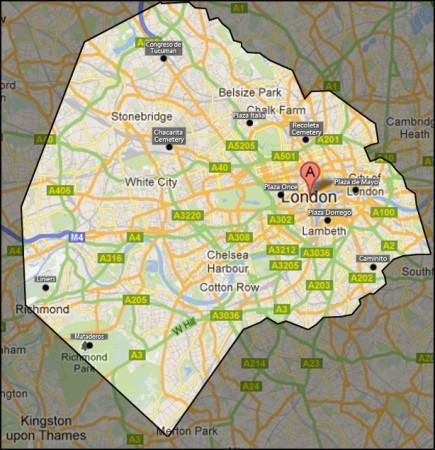Buenos Aires, the vibrant capital of Argentina, often evokes comparisons to other world-renowned cities. Frequently dubbed the “Paris of the South,” its European-style architecture and bustling avenues invite thoughts of Parisian boulevards. The revitalized Puerto Madero waterfront area is sometimes likened to Manhattan’s sleek modernity, and the expansive green spaces of Palermo Park can remind visitors of New York’s Central Park. These casual comparisons are intriguing, but how does Buenos Aires truly measure up against other major global cities when we look at concrete metrics like geographical size? Knowing that Buenos Aires covers approximately 80 square miles and is home to just under 3 million people provides a starting point. However, to truly grasp the scale of this metropolis, visualizing it alongside cities we are more familiar with offers a much clearer perspective. Let’s explore how Buenos Aires compares in size to several prominent cities around the globe.
First, let’s consider London. The image above overlays the outline of Buenos Aires onto a map of London at the same scale. To provide familiar points of reference, key Buenos Aires landmarks are positioned relative to London locations. Plaza de Mayo, the historical heart of Buenos Aires, is placed near London Bridge. Following this alignment, Plaza Dorrego, known for its antiques market, falls around Waterloo. Caminito, the colorful street in La Boca, appears in the Peckham area, while Plaza Italia in Palermo aligns with Primrose Hill, beyond Regent’s Park. Lastly, Congreso de Tucuman, situated further out in Buenos Aires, extends into the Hendon area of London. This visual comparison clearly illustrates that Buenos Aires, even just the Capital Federal, is significantly smaller than Greater London, demonstrating a notable difference in city size.
Next, we turn to Paris, often romantically linked to Buenos Aires. Comparing city sizes, however, reveals a different story. As depicted in the image, the Périphérique, Paris’s ring road, fits comfortably within the boundaries of Buenos Aires’ Capital Federal. A journey from Recoleta, Buenos Aires’ upscale neighborhood, to Mataderos, known for its traditional market, traverses the entirety of Paris if overlaid. While architectural similarities might inspire the “Paris of the South” moniker, Buenos Aires encompasses a considerably larger geographical area than central Paris. This city size comparison emphasizes that despite shared cultural influences, the urban scale differs significantly.
Moving across the Atlantic to New York City, the comparison shifts again. Here, the scale appears more aligned, yet still reveals interesting differences in city sizes. The five boroughs of New York City dwarf Buenos Aires’ Capital Federal. When superimposed, Mataderos reaches down towards Governor’s Island, while Plaza de Mayo extends up towards Jackson Heights and La Guardia Airport in Queens. This city size comparison highlights that while both are major urban centers, New York City, encompassing its broader five boroughs, occupies a larger area than the core of Buenos Aires.
Contrasting Buenos Aires with San Francisco offers another perspective on city size. San Francisco, a geographically compact city, fits neatly within the Argentine capital. If Recoleta is considered downtown San Francisco, then Congreso de Tucuman would be located beyond the Golden Gate Bridge, and reaching the market at Liniers would require a metaphorical boat trip across a bay in this scaled comparison. This image clearly demonstrates that Buenos Aires is considerably larger than San Francisco, emphasizing the expansive nature of the South American metropolis compared to the Californian city.
Comparing Buenos Aires to Geneva, the author’s former hometown, further emphasizes the scale difference. Geneva is completely overshadowed by Buenos Aires in this city size comparison. The entire city of Geneva is approximately one-tenth the size of Buenos Aires. In this visual, Caminito and the end of the D subway line in Buenos Aires both find themselves situated in France, on either side of Geneva, near the location where Jorge Luis Borges, one of Buenos Aires’ most celebrated writers, is buried. This starkly illustrates the vast difference in geographical area between these two cities.
**UPDATE**
As per a reader’s request, we now compare Buenos Aires to Los Angeles, a city known for its urban sprawl. This city size comparison reveals a dramatic difference. Los Angeles dwarfs Buenos Aires, highlighting the sheer extent of LA’s urban area.
Finally, for a specific request, we compare Buenos Aires to Stockport (near Manchester, UK). This city size comparison underscores the vast difference in scale, with Stockport appearing minuscule in comparison to Buenos Aires.
These visual comparisons, while not perfectly precise, offer an engaging and relatable way to understand the size of Buenos Aires in relation to other global cities. They help to contextualize the distances within Buenos Aires and provide a clearer sense of its urban scale. While Buenos Aires might share cultural echoes with cities like Paris or architectural similarities with parts of New York, its geographical footprint presents its own unique dimensions when placed alongside cities of varying sizes around the world.

